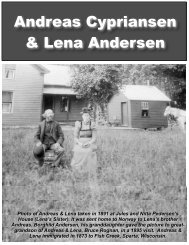Viking Heraldy of Lewis & Cinda - Bruce Rognan
Viking Heraldy of Lewis & Cinda - Bruce Rognan
Viking Heraldy of Lewis & Cinda - Bruce Rognan
Create successful ePaper yourself
Turn your PDF publications into a flip-book with our unique Google optimized e-Paper software.
Visbur ruled over the Svearne (Swedes) after his father’s death. His wife was the daughter <strong>of</strong> Aude, a wealthy<br />
man, who gave three large estates and a gold ornament as a dowry with his daughter. Two sons were born,<br />
namely, Gisl and Andur. He deserted his wife and married another woman, so she took her two sons and went<br />
back to Finland to live with her father. Visbur had a son named Domalde by his second wife. His first wife<br />
urged her sons to claim the property which was given to him as a dowry. Visbur refuse to agree to this. His<br />
former wife then instituted witchery against him. It was prophesied that the gold ornament would be a curse<br />
and cause the death <strong>of</strong> the best man <strong>of</strong> his race. The sorcerer also granted the sons permission to take the life<br />
<strong>of</strong> their father, and also prophesied that murder <strong>of</strong> kinsmen in the <strong>Viking</strong> dynasty would become prevalent in the<br />
future. Afterwards, the sons gathered a group <strong>of</strong> people at night-time, set fire to Visbur’s sleeping quarter, burning<br />
him to death.<br />
Domalde Visburson (135 AD)<br />
Domalde became the next king <strong>of</strong> Svitjod after his father, Visbur. During his reign there was hunger and famine<br />
in the land, and the <strong>Viking</strong>s made great sacrifices and altar <strong>of</strong>ferings. But famine still prevailed. The first fall<br />
they sacrificed oxen, but to no avail. Next fall the Swedes came in a large force to Uppsala, where the sacrifices<br />
were to be held. The debated and agreed that their king must be responsible for their troubles and decided<br />
that they would make him their sacrifice to their god Odin and paint the pedestals in the temple with his<br />
blood. This was done. Domar began trading with the Romans under Emperor Hadrian. He allowed the Romans<br />
to use the fertile fishing harbors <strong>of</strong> Vagar (Kabelvag, Norway) to provide dry cod fish for use. Once the Romans<br />
discovered dry fish could be exported from north Norway’s coast, the area became the center for administering<br />
this trade. Roman coins, silver mugs, and bronze vessels dating to the period <strong>of</strong> Emperor Hadrian have been<br />
excavated in L<strong>of</strong>oten Islands in the 1950's.<br />
Domar Domaldeson (165 AD)<br />
Domar, the son <strong>of</strong> Domalde, became the next king <strong>of</strong> the <strong>Viking</strong>s. During his long reign the country prospered<br />
and peace prevailed. Of him nothing is told, except that he died <strong>of</strong> disease at Uppsala; his body was taken to<br />
Fyres Plains and burned. A stone monument was erected at the mouth <strong>of</strong> Fyres brook between old Uppsala<br />
and the new Uppsala.<br />
Drygve Domarson (200 AD)<br />
Drygve, the son <strong>of</strong> Domar, then became king <strong>of</strong> the <strong>Viking</strong>s. He also died a natural<br />
death. Nothing is recorded <strong>of</strong> him, except that he was the first man to be called Konge,<br />
(king). Previously they were called Drottner, their wives, Drottninger, and their bodyguards,<br />
Drott. Every man in the dynasty was also known as Yngve, and Ynglinger.<br />
Eventually the <strong>Viking</strong> Dynasty is known as the “Yngling Dynasty” as a result.<br />
Dag Drygveson (235 AD)<br />
Dag, the son <strong>of</strong> Drygve, became the next king. He was a very wise man, and was said<br />
to understand the language <strong>of</strong> birds. He had a sparrow which told him many tidings from<br />
afar. On one occasion the sparrow flew to Denmark where it settled in a peasant’s orchard<br />
and ate berries. The peasant picked up a stone and killed the bird by hitting it.<br />
King Dag became anxious when the bird did not come back so he went to a sacrifice<br />
made to the gods., where he asked about his bird. He was told what had happened. He<br />
gathered a force and went to Denmark to revenge the sparrow’s death. He ravaged the country side, but on<br />
their way back to their ships someone cast a pitchfork into the group <strong>of</strong> men and it hit the head <strong>of</strong> the king which<br />
cause his death<br />
Agne Dagson (270 AD)<br />
Agne was a highly renowned and a powerful king. He went on a pirate expedition into Finland, won a great victory<br />
over the Finnish King Froste who was killed in action. He conquered the country, took a large number <strong>of</strong><br />
prisoners and much plunder, captured Froste’s daughter, Skjaalv, and son, Loge. He married Skjaalv, with<br />
whom he had two sons, Alrek and Eirik. When he returned to his own country, he pitched his tents at Stoksund<br />
(Now Norrstrom, between Maelaren and the sea, on the north side <strong>of</strong> old Stockholm.). His wife, Skjaalv, asked<br />
him to prepare a funeral feast in honour <strong>of</strong> her dead father, which he did. He invited many prominent men and<br />
prepared a great banquet. He had become greatly renowned because <strong>of</strong> his expedition into Finland. There



